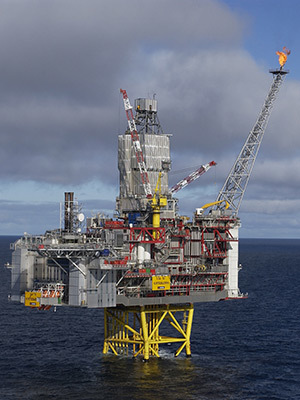
Petrleuum activities in the Norwegian sector produced 400,000 tonnes more CO2 emissions in 2015 than the previous year, according to figures released by authorities.
In 2015, the activities generated 13.5 million tonnes of CO2 emissions, an increase of 400,000 tonnes (3%) compared with 2014.
The primary cause of the increase, according the Norwegian Petroleum Directorate, is start-up difficulties on the Knarr field and start-up of the Valemon and Edvard Grieg fields, which started producing in 2015.
Total CO2 emissions from producing fields that were operational before 2015 are on the same level as in 2014.
NOx (nitrogen oxides) emissions are down 11% (5600 tonnes). This is primarily due to reduced drilling activity and use of mobile facilities.
The NPD prognosis for the next five years shows that CO2 emissions will stabilise around the 2015 level, even as several new fields start production.
The Johan Sverdrup field will be supplied with power from shore. Edvard Grieg, Ivar Aasen and Gina Krog will also receive power from shore in connection with the second development stage for Johan Sverdrup.
“The authorities have a good overview of emissions from the petroleum sector in Norway. The Norwegian Oil and Gas Association has established a joint database for reporting discharges to sea and emissions to air from the activities. All operators on the Norwegian continental shelf report discharge/emission data directly into this database,” the NPD said in a statement.
Emissions are largely generated as a result of combustion of gas and diesel in turbines, engines and boilers that keep oil and gas facilities operational. Safety flaring of gas also generates CO2. Ventilating and diffuse gas emissions from storage and loading of crude oil are also sources of emissions.
Total nmVOC emissions (volatile oil compounds, oil vapour) amounted to 46,500 tonnes in 2015, six per cent less than in 2014. Methane emissions (CH4) amounted to 28,900 tonnes in 2015, eight per cent less than in 2014.
Emissions in the petroleum sector originate from facilities on the shelf and from the onshore facilities that are covered under the Petroleum Taxation Act.
These emissions are regulated by the Petroleum Act, CO2 Tax Act, Act concerning special tax, Greenhouse Gas Emission Trading Act and the Pollution Control Act, among others.
Statistics Norway (SSB), which recently published preliminary 2015 figures for Norwegian greenhouse gas emissions, also includes emissions from the part of onshore facilities that are not covered under the above definition.
Recommended for you
